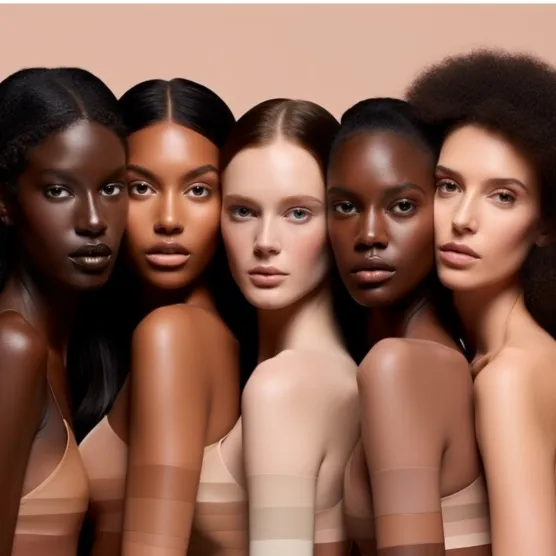In the dynamic world of beauty, the call for inclusivity echoes louder than ever. The beauty industry, once criticized for its limited representation, is undergoing a profound transformation, and at the forefront of this change is the evolution of foundation ranges. This article delves into the journey of inclusive foundation shades, exploring the challenges, triumphs, and the impact of this revolution on individuals across the spectrum of skin tones.
Introduction
The Historical Lack of Inclusivity
For decades, individuals with deeper or richer skin tones struggled to find foundation shades that complemented their unique undertones. Many beauty brands offered limited options, perpetuating a beauty standard that excluded a significant portion of the population.
The Turning Point
The shift towards inclusivity gained momentum in recent years, fueled by consumer demand for diversity and representation. Beauty enthusiasts, influencers, and advocacy groups took to social media, calling out brands to broaden their shade ranges and championing the cause of makeup for all.
The Rise of Inclusive Foundation Ranges
Brand Initiatives
- Fenty Beauty by Rihanna: A Game-Changer
- Rihanna’s Fenty Beauty disrupted the industry by launching a groundbreaking 40-shade foundation range. This move set a new standard for inclusivity and prompted other brands to follow suit.
- Expanding the Spectrum: MAC Cosmetics
- MAC Cosmetics, a pioneer in diversity, expanded its foundation range to accommodate a broader range of skin tones, acknowledging that beauty knows no boundaries.
Technological Advances
- Color Matching Technology
- The advent of technology, such as AI-driven color matching tools, has revolutionized the way individuals find their perfect foundation match, making the shopping experience more accessible and accurate.
- Customization Options
- Some brands offer customizable foundation options, allowing consumers to mix shades or adjust undertones for a truly personalized match.
The Impact on Representation
Redefining Beauty Standards
- Cultural Appreciation
- Inclusive foundation ranges celebrate and appreciate the diverse beauty standards that exist across various cultures, challenging the notion that there is a one-size-fits-all definition of beauty.
- Promoting Self-Love
- Individuals with traditionally underrepresented skin tones are empowered to embrace their natural beauty, fostering self-love and confidence.
Influencer and Celebrity Collaborations
- Collaborations as Catalysts
- Influencers and celebrities have collaborated with beauty brands to create inclusive foundation lines, amplifying the message of representation and inclusivity.
- Impact on Consumer Choices
- Consumers are increasingly drawn to brands that align with their values, driving the demand for inclusive products and reshaping the beauty market.
Overcoming Challenges
Color Accuracy and Undertones
- The Undertone Challenge
- Achieving accurate undertones remains a challenge, and some brands continue to refine their formulations to cater to the nuanced diversity of undertones.
- Feedback and Iteration
- Brands that actively seek feedback from their consumers and iterate on their formulations demonstrate a commitment to continuous improvement.
Accessibility and Affordability
- Addressing Price Disparities
- Inclusivity should extend beyond shade ranges to address price disparities, ensuring that high-quality products are accessible to a wide range of consumers.
- Retailer Education
- Retailers play a crucial role in educating staff about the importance of inclusivity, enabling them to assist customers in finding their perfect match.
The Future of Inclusive Foundation Ranges
Sustainable and Ethical Practices
- Cruelty-Free and Vegan Options
- The future of inclusive beauty includes a focus on cruelty-free and vegan formulations, aligning with the growing demand for ethical and sustainable practices.
- Eco-Friendly Packaging
- Brands are exploring eco-friendly packaging options, addressing not only the diversity of skin tones but also the impact of beauty products on the environment.
Continued Advocacy and Education
- Advocacy Through Education
- Continued advocacy efforts and educational initiatives are crucial to fostering a beauty landscape that celebrates diversity and rejects outdated standards.
- Empowering the Next Generation
- Industry leaders, influencers, and educators have a responsibility to empower the next generation of beauty enthusiasts by promoting inclusivity and self-expression.
Conclusion
The evolution of inclusive foundation ranges signifies a monumental shift in the beauty industry’s approach to diversity and representation. As brands continue to embrace inclusivity, the impact extends far beyond the realm of makeup, influencing societal perceptions of beauty and empowering individuals to feel seen, valued, and celebrated. The journey is ongoing, but the strides made thus far serve as a testament to the transformative power of makeup and the collective commitment to a beauty industry that truly caters to Shades for All.



